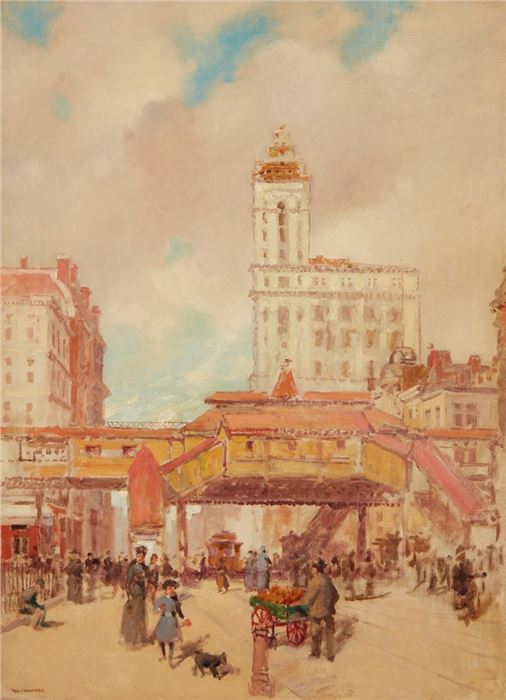Paul Cornoyer鈥檚 New York
Paul Cornoyer鈥檚 urban scenes capture New York鈥檚 changing moods through parks, streets, and seasons
Kristen Osborne-Bartucca / 黑料不打烊
10 Oct, 2025
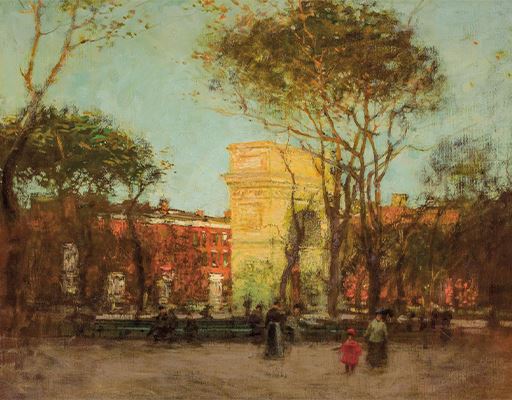
One could easily make the case that Paul Cornoyer (1864-1923) was an Impressionist. His brushstrokes are lithely applied. The interplay between light and shadow is conspicuous. There is energy, vivacity, and modernity in the subject matter and in the style. It’s also possible to make the case that Cornoyer was a Tonalist, committed to softening the edges of constant construction and chaos of the modern city with a dreamlike, romantic atmosphere. Maybe he could even be classified as one of the Ashcan artists, if not one of The Eight, then one of those painters on the periphery. His scenes are urban spaces populated not just by the elite but by the middle class, and sometimes his palette is gloomy, with the grime of the city, if not explicitly depicted, often alluded to. But perhaps it’s best just to take Cornoyer as he is, both a part of the prevailing painterly trends and movements during his time and someone who did not let himself be circumscribed by them.

One thing that is indisputable is that he was a painter of New York. In 1913 fellow New York painter Childe Hassam explained that “the portrait of a city…is in a way like the portrait of a person – the difficulty is to catch not only the superficial resemblance but the inner self…One should strive to portray the soul of a city with the same care as the soul of a sitter.” Cornoyer, in his dozens of works of city squares, streets, and the changing seasons, seems to have taken that to heart. He gives us a simultaneously charming, dreary, busy, quiet, familiar, unpredictable city, a city possessed, as F. Scott Fitzgerald wrote in The Great Gatsby, “of the mystery and of the beauty of the world.” To help understand his New York oeuvre, we can consider three loose and sometimes overlapping categories: squares and parks; seasons; and street scenes.
Squares and Parks
Cornoyer’s park scenes usually feature a lawn or monument (such as the Washington Square Arch) surrounded by a walking path; slender, curving trees nearly bare of foliage to better show the clusters of surrounding buildings, and people strolling along, their features indistinguishable but their attire marking them as middle or upper-middle class. His preferred seasons are fall and winter, perhaps being better situated to experiment aesthetically with the atmospheric effects of inclement weather and earlier sunsets.
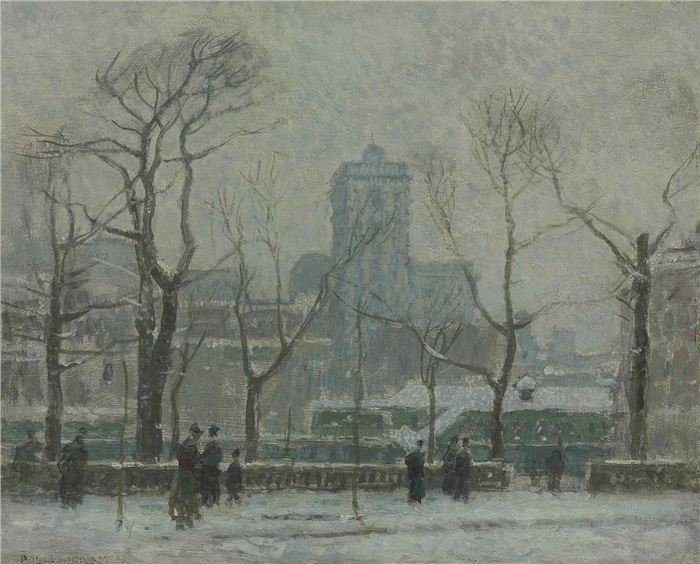
There may be similar elements in Cornoyer’s parks and squares, but they possess nuance and are far from quotidian. Winter Bryant Park, n.d., for example, is undeniably dreary. The mottled gray sky is heavy with the threat of more snow, which covers the ground and rooftops and spindly branches of bare trees. The cheerless people walking along the edge of the park are bundled against the cold.

Only a handful of perambulating figures populate the equally frosty Washington Square in Winter, n.d. and Winter, Washington Square, n.d. The benches are empty and the Arch is marmoreal and indifferent, an elegant glacier looming in the distance. There is another scene of Washington Square Park in what looks to be the fall, as the trees have leaves but are far from verdant. The sun is beginning its descent, as parts of the park have fallen into shadow while the sky remains golden. A child’s bright crimson coat is mirrored in the red buildings framing the park, giving the scene a bit of whimsy.
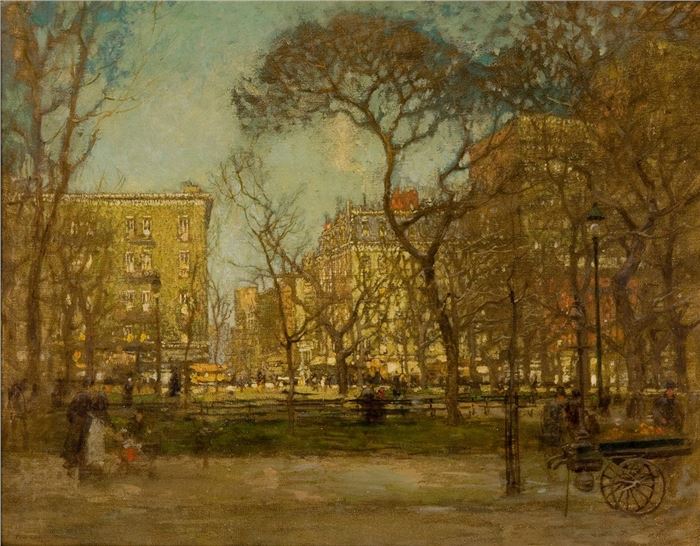
Cornoyer’s favorite park was Madison Square, which he asserted was the most beautiful space in the city. Novelist Willa Cather described it in her 1915 novel My Mortal Enemy as “then at the parting of the ways; [it] had a double personality, half commercial, half social, with shops to the south and residences to the north. It seemed to me so neat, after the raggedness of our Western cities; so protected by good manners and courtesy – like an open-air drawing-room.” Cornoyer’s paintings largely embody Cather’s sentiments, presenting it in works like After the Rain, c. 1900, Madison Square, c. 1905, Madison Square Park, n.d. as a space for leisure and also one embedded in the heart of a bustling, commercial district. In one of the works, for example, the skeletal structure of a new skyscraper rises high into the sky, almost dwarfing the spires of its neighboring churches.
Seasons
Paul Cornoyer, Rainy Day, New York, n.d.
Cornoyer isn’t the only turn-of-the-century New York painter to delight in the variances of the seasons as they manifested in the metropolis, but his rainy and snowy scenes are particularly evocative. Some, like the aforementioned Winter in Bryant Park and Winter in the City, n.d., are explicitly chilly, somber scenes, while others acknowledge the difficulties of navigating a wet or wintry city. Yet they still appreciate the picturesque quality of twinkling lights reflecting on slick pavement or windows representing cozy respites from the weather.
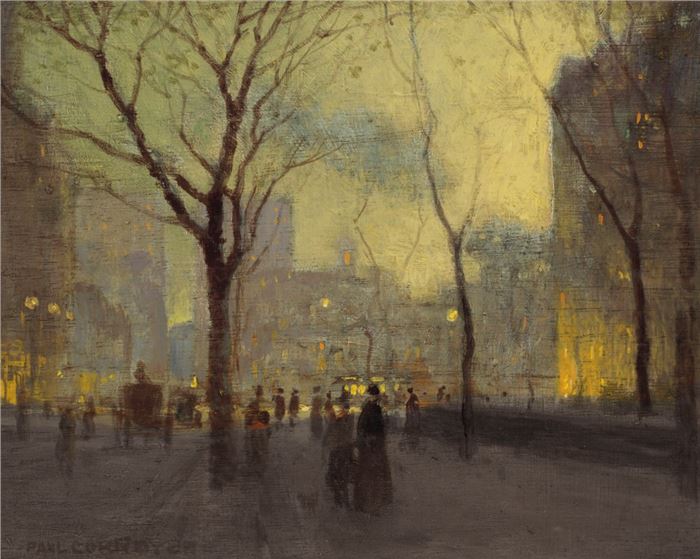
Two works of the Plaza, Plaza Hotel in the Rain, n.d. and The Plaza After the Rain, 1908, are particularly dreamy. In the former, the rain itself is barely discernible, with the main focus a crepuscular scene of streetlamps and windows in the titular hotel and surrounding buildings lighting up in hues of warm orange and gold. The people walking about on the sidewalk and in the street seem indifferent to the rain, as living in a city no doubt inures one to the minor inconveniences associated with getting from here to there. The latter work is depicted from exactly the same vantage point, but now the rain has stopped, leaving the streets sodden but the sky creamy yellow and periwinkle, a promise of the sunshine to come.
Streets
Paul Cornoyer, Third Avenue, New York, n.d.
A final category of Cornoyer’s works is that of the city streets, which, if not quite the Ashcan artists’ crowded, raucous sites where denizens constantly move between both anonymity and performativity, are still illustrative of what life in the modern city looked and felt like. In Chelsea, n.d., the elevated station stretches over the street in which someone sweeps and others walk. Columbus Circle, n.d., shows the circle on a golden afternoon, pedestrians and streetcars sharing the street. A late work, The Flatiron Building, n.d., shows the titular building not from Madison Square Park but from the street, at an angle that emphasizes the vertiginous architectural trends of the 1910s. In Third Avenue, New York, n.d., perhaps the most populated of all Cornoyer’s city works, the elevated makes another appearance, but it’s the crowded street with children, dogs, pushcarts, and dozens of men and women walking, talking, and sitting that offers the real visual interest.
Cornoyer’s New York scenes, then, are of familiar sites and spaces and feature the same subjects multiple times, but each painting has a uniqueness, a bit of magic – to return to Fitzgerald, it is always like “the city seen for the first time.”
For more on auctions, exhibitions, and current trends, visit our Magazine Page

 ARTISTS
ARTISTS








